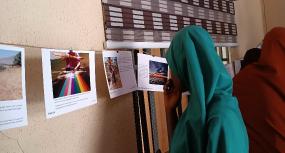Activity Plan
Introduction
Photovoice is a visual methodology that combines photography and storytelling to enable reflection on community issues and lived experiences. Photovoice is often used to generate critical dialogue and knowledge about important issues.
This activity plan was inspired by the TRANSFORM summit and exhibit which engaged youth to participate in using photovoice to challenge gender norms.
Activity Overview


Activity Goals
Begin with a warm-up activity to engage the participants in a brief introduction to photovoice, what it is, and how to use a camera.
Participants will engage in a phototaking activity to explore their surroundings to capture pictures significant to them to answer a reflective prompt/question.
Participants will discuss and analyse the chosen pictures and create a photo narrative.
Facilitate the creative engagement of participants and empower them to tell their stories and communicate these to each other and the wider public.
Visually depict situations or events that may be difficult to talk about or put into words.
Allow participants to centre their voices and share their experiences and knowledge as members of marginalized groups.
Photovoice
Activity Plan
Supplies
Cameras or cellphones
portable printer for hardcopies or an LCD projector to display photos, paper or cardboard pens or any writing materials
STEP #1: Introduction


Introduce the photovoice method by explaining what it is and why we use it: photovoice is a social medium that records reality and communicates events through photography, we can reflect and share our perspectives with peers, community members, and those who can bring positive social change
Give participants an opportunity to experiment with the cameras to prepare to take photos. Discuss the prompt/question you will have students answer through photovoice.
STEP #2: Photography Visual Ethics
Introduce the visual ethics of taking photos. Present some examples and ask: Is the person aware they are being photographed? Is this photograph revealing someone? How do I make this photograph less revealing?
Participants must know that it is integral to ask permission from the person photographed or to take photos in public places. There will be fewer ethical concerns if the photographer takes pictures of inanimate objects or in ways in which people cannot be identified (Ex- taking pictures of hands or silhouettes).
Activity Plan
STEP #3: Photo Taking Activity

1) Divide participants into groups of 2-5 people and instruct them to take no more than 15-20 pictures to answer the prompt/question.
2) Ask them to take a picture of their group (this will give them practice and make it easier to match the participants with the photographs).
3) Establish where the participants can venture to take pictures (outside, in the workshop room etc.) and let them know the amount of time (30-40 minutes) they have to take pictures. Send participants off to take photos!
4) Prepare the photographs in hard copies by printing them out with a portable printer or have them printed locally). Photos can also be displayed through an LCD projector.
STEP #4: Participant-Led Analysis
This is an important step in the participatory nature of this work, as the photographers can comment on the photographs and look at everyone’s work. Start a discussion with participants about the photos captured and the issues depicted, using the SHOWED model:
What do we See or how do we name this problem?
What is really Happening?
How does the story relate to Our lives?
Why does this problem or strength exist? What are the root causes? How might we become Empowered now that we better understand the problem?
What can we Do about it?
Photovoice
Activity Plan
STEP #5: Captions

Give participants time to come up with captions for their photos. These should be short sentences/phrases in response to the prompt OPTIONAL: Participants can select 8-10 photographs to mount. Hand out paper or cardboard and writing instruments and allow time for the group to write relevant comments/captions next to the photos, creating a title for the entire collection. Per your preference, photo narratives can also be created digitally.
STEP #6: Presentation
Each group should present their photovoice or narratives to the larger group. Encourage other groups to listen to the presentations, raise questions, and contribute comments about the photos.
Post-Activity Reflections
Set aside some time for a discussion after the activity to hear feedback from the group:
What did you like?
What did you learn?
What did your images say about the issue under investigation?
What were some of the problems you had?
If you were doing this again, how would you do it differently?
Who do you think should see their images? Why?
What do you hope our exhibition will accomplish?


Images from day 1 of the school-based exhibition in Mwasi in the Kilimanjaro Region of Tanzania

